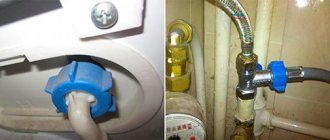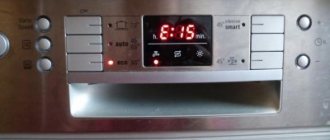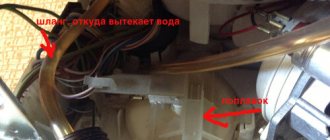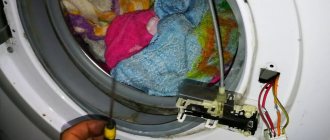Leaking appliances are a common problem faced by dishwasher owners. It manifests itself in one of the following ways or both at the same time:
- Leaking from under the door. Water is leaking from underneath the dishwasher door.
- Aquastop works. Water leaks into the dishwasher tray, located below it. Because of this, the leakage protection system is activated and the drain pump is turned on.
Note! If the Aquastop leak protection has worked, then whenever you turn on the dishwasher, it will start the drain pump (you will hear its noise) and will stop responding to commands from the buttons or control sensor. Moreover, in some machine models, the drain pump continues to work even if you turn off the dishwasher with the power button. To avoid failure of the drain pump, we recommend that in such models you unplug the plug from the socket before calling a technician.
In this material we will explain in detail why a dishwasher leaks, whether this always indicates a malfunction, and what to do in case of a leak.
Water leak.
If water constantly accumulates on the floor, it can cause the floor to warp. It will begin to rot. Where moisture accumulates, mold will grow. You will smell an unpleasant odor. Also, water will spread down the floor, and there is a risk of damage to the neighbors' ceiling. To prevent this from happening, it is recommended to know the causes of leaks.
The photo shows the water supply valve.
Hose is leaking
Symptoms: leaking from under the car or under the hose
Drain and inlet hoses are fragile products; they can break, crack, fray, or simply be defective from the very beginning. Gaskets often leak at the places where hoses are attached: they may simply not be fully tightened, the gaskets are of poor quality, or the hoses were screwed on by someone with crooked hands and the gasket was skewed.
Whatever happens to the hose, you can easily fix it yourself: tighten the crack with electrical tape, seal it with waterproof glue, and seal it with a gasket. Just keep in mind that all these are temporary measures and with strong pressure the leak may appear again. If the hose is damaged, it is better to replace it, especially since it is not that expensive.
The most common problems.
What causes a leak? A leak does not mean a puddle under the car. Sometimes there may be:
- Drops on the floor after washing dishes.
- Condensation from water vapor. Steam accumulates on the door of the device, and after opening the door it falls on the floor in the form of water.
- Moisture appears under the device.
Any problem can be solved. Drops on the floor may occur due to condensation. It's just that when you open the door they end up on the floor. This does not mean that the dishwasher is leaking or broken. Another problem is if condensation constantly accumulates at the bottom of the device. In such cases, you should wait some time after the device has been operating, and only then open it. Wait until the condensation has completely evaporated. And if drops appear on the door, you can wipe them off with a towel or dry rag.
Dishwasher tank leaking
Symptoms: Water under the dishwasher.
To damage such a strong part as a dishwasher tank, you have to try hard, but it also happens: it can be pierced by something sharp, or it can crack due to improper use or a manufacturing defect.
If, during a visual inspection of the tank from the inside, you do not notice anything suspicious, you need to partially disassemble the car and look for traces of leaks inside. It is better, of course, to turn to professionals for such work.
Water flows from the bottom of the device.
With this type of leak, you need to pay attention to the hose. There are several reasons for its leakage:
- A crack appeared on it.
- The seal was broken.
- Slight weakening.
Such cases occur when the dishwasher has been used for several years. Fixing this breakdown is very simple. It is enough to buy a new hose and two clamps needed for a tight connection. All this is inexpensive.
If water flows from the bottom of the device and a large puddle appears, the cause may be a malfunction of the valve through which water flows. He is responsible for the amount of water. If the valve is stuck and it is opened, a flood will occur.
Dispenser leaking
Symptoms: a leak appears while drawing water
If a leak appears almost as soon as water begins to flow into the chamber, then the detergent tray (dispenser) is most likely to blame. There may be undissolved powder left in it, or the tray may simply be cracked and leaking. Powder may remain in the dispenser if you poured too much of it, or used a low-quality powder that does not dissolve well. In any case, if you find any remaining powder in the tray, clean it.
The cause of a leak from the dispenser may also be too high a water pressure: try closing the water supply tap to the machine a little and monitor the reaction.
Types of faults.
The photo shows a dishwasher tray.
Your dishwasher can leak if you use bad detergent. They can create a lot of foam that penetrates any seals.
Some dishwashers may not function properly if the jets are not directed correctly. This downloads the following brands:
- Simens.
- Veko.
- Candy.
- Bosch.
- Indesit.
In this case, the car begins to leak because water splashes heavily near the door or below. Moisture accumulation begins at the bottom of the device. If your car leaks heavily, this is the first thing you should check for. It is also necessary to check the door seal of the device and clean it from:
- Fatty particles.
- Residues of dishwashing detergent.
- Mud.
- Leftover food.
In the worst case scenario, you will have to completely replace the seal.
What other reasons could there be?
Another cause of failure is damage to the seal in the pump. In addition, a problem may arise due to damage to the drain or inlet hose. You can find the cause of the breakdown if you remove the bottom panel of the device. In this case, it is necessary that it be turned on. This way you will see where the water is flowing from. Just watch carefully for moisture buildup. But be careful with the wires. They are energized, and water conducts electricity well and therefore the dishwasher can give an electric shock.
Another known problem is the formation of holes through which species can flow. Sometimes the reason is a poorly closed latch on the door. It may be damaged or bent, causing water to flow under the car. Another reason is the seal on the door. Cracks may also form on it. Especially if the machine has been running for several years.
What are the problems with power cords?
The power cord itself, if you follow the rules of its operation, will not break. This is an ordinary cable and there is nothing to break in it. But if you are careless about its storage and transportation, and if the cord is not used for its intended purpose, then it may well deteriorate.
Users will either weigh down the cord or use it as a securing device during transportation. As a result, the copper cores of the cord are damaged and the cord fails. In such cases, a more dangerous phenomenon may occur - overheating and burnout of the cord. This, in turn, can cause a fire.
The integrity of the cable is checked by reading its actual resistance. A multimeter is used for this. If the resistance is high, the cable is rejected and sent as scrap.
Other reasons.
The photo shows a Bosch dishwasher inside.
There are several other reasons for leakage:
- If water is leaking from the bottom of the door, the dishwasher may be askew or positioned incorrectly. In addition, the cause of this may be contamination of the pipe. The sensor that regulates the water level in the device could also break. The door seal may have been smeared, or grease may have accumulated on it. You can clean it with a cloth. If it is damaged, it will have to be replaced.
- The machine may leak from below if the rubber pipe is torn or poorly connected. This is a fairly common problem in cheap dishwashers (sellers skimped on quality). Another reason could be old equipment.
- The cause may be the air gap in the drain valve. A piece is installed in the drain hose to prevent water from flowing into the drain. Water may leak from the vent if the hole in the hose is too small or clogged with grease and dirt. But then leakage will occur while draining the water.
- The container containing the water is damaged. The tank may have burst. In this case, a puddle will appear under the car. This problem is quite rare.
- Sprinkler is faulty. Also quite rare. If it is damaged, water will begin to enter all parts of the machine and accumulate at the bottom.
Is it possible to fix the problem yourself?
If you are familiar with the instructions and know where the device parts are located, you can try to fix the problem yourself.
If water is leaking from the bottom of the door
This is the most easily repaired breakdown. You can buy rubber bands at any hardware store. Please note that each brand of dishwasher requires a different eraser.
To replace the rubber on the door you need:
- Open the doors and unscrew the bolts around the perimeter.
- Close the door and remove the front panel.
- Now open the door and remove the dish basket.
- Using tweezers, remove the sealant layer.
- We install a new one. Its end should coincide with the edge of the water container.
- We put the panel back.
If the problem is in the hose and pipe.
You need to clean the filters and hoses in your dishwasher of food residue and grease. The filter is located at the bottom of the water container. You need to remove the mesh and unscrew the cup. Wash everything under water and put it back.
If there is a problem with the hose or pipe, they also just need to be washed with water.
And if one of the listed parts is damaged, you will have to replace it.
Cleaning the car with napkins.
Replacing a valve, sprinkler or water sensor.
If there is rust on the fill valve, it will need to be replaced. Just disconnect the pipes and sensors from it, and install a new one.
It is very rare, but it happens that due to water pressure, the sprinkler begins to delaminate. Water begins to flow into the pan. You can buy a new sprinkler and replace it yourself. It may be located in different places depending on the brand of dishwasher. Most often it is installed under the dish basket. The sprinkler is held in place by latches. Just pull it out with a screwdriver and install a new one.
The tank burst.
Sometimes it happens that the water container bursts. Most often this happens if the device is already old. Here you will have to contact a specialist. Most often, damage to the tank leads to the purchase of a new dishwasher, since repairs are expensive.
In almost all cases, except the last one, parts can be replaced with your own hands.
What to do if Aquastop works, how to unlock it
- Turn off the PMM. Press the on/off button and then remove the plug from the outlet.
- Remove water from the pan. To do this, pull out the machine and tilt it slightly towards you. Alternatively, remove the side of the dishwasher and wipe off the water in the tray with a rag.
- Make sure it is the dishwasher that is leaking. Plug in the machine and start the program again. While washing, observe the operation of the machine and the surrounding plumbing (if it is leaking!). If Aquastop works again, then you need to look for a leak in the machine itself. Did the wash go without any problems? This means that water got into the pan for some external reason: regular (for example, a sewer leak) or one-time (for example, a child spilled water on the floor next to the car).
Note! If the leakage protection system in the dishwasher is activated, but there is no water in the tray, this indicates a malfunction of the Aquastop sensor or control unit. For more details, see the list of breakdowns below.
Adviсe.
If you decide to buy a dishwasher, choose the device from trusted places. Do not try to save on price and quality, so as not to run into a bad product.
Pay special attention to the choice of detergent. The service life of the dishwasher also depends on this.
The device must be maintained regularly. Wash the dishwasher on time, remove all food residues and dishwashing detergents. Also check parts for corrosion or cracking.
As you can see, there are many reasons why a dishwasher leaks. You can determine the damage yourself by removing the bottom panel of the device. If you fail, you can always turn to an expert for help.
Also, by clicking on the link, you can find out about another breakdown: For what reasons does the water not drain from the dishwasher?
How to clean the PMM camera?
It is recommended to remove the effects of active foaming step by step:
- Disconnect the machine from the power supply. Remove all dishes from the dishwasher compartment and scoop out the foam into the prepared basin.
- Use a washing vacuum cleaner - if you have one. It has filters that allow you to suck in water.
- Wipe the bottom of the hopper thoroughly with a sponge.
- Wipe with a dry cloth to remove any remaining moisture. Be careful when working: you can get burned on parts that become hot during operation.
When the chamber is cleaned, all that remains is to use one of the foam-absorbing agents.
- Salt and Vinegar. Pour vinegar directly into the bottom. Half a glass is enough. Sprinkle the vinegar with salt on top - two or three handfuls are enough. Start the dishwasher and let it run for a minute or two. After turning off the device, look into the bunker. If traces of foam are still present, repeat the vinegar-salt procedure. You need to repeat until the chamber is completely clear of bubbling liquid.
- Olive oil. This technique is recommended by the PMM manufacturers themselves. If you don't have olive oil, any vegetable oil will do. Pour half a glass of oil into the bottom and start the machine. One cycle is enough to destroy traces of foam.










